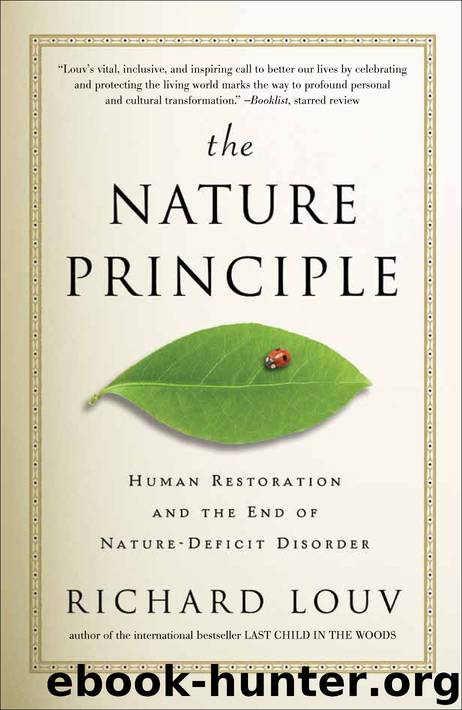The Nature Principle by Richard Louv

Author:Richard Louv
Language: eng
Format: epub
Publisher: Algonquin Books
Published: 2011-06-14T16:00:00+00:00
• Rebuild local food webs. Nothing lives in isolation. Every species exists within complexes of interacting species that ecologists call food webs. For a species to thrive in your yard, you must provide the fundamental parts of that species’ food web.
• It all starts with plants. Food webs start with plants, because plants are the only organisms (with the exception of some bacteria) that can capture the sun’s energy, which fuels life on earth. All animals get the energy they need either by eating plants directly or by eating other animals that eat plants. The amount of vegetation in your yard will determine the amount of nature in your yard.
• All plants are not the same. Unfortunately, all plants are not equal in their ability to support food webs. Food webs develop locally over thousands of generations, with each member of the web adapting to the particular traits of the other members of the web. A plant that evolved outside of a particular food web is usually unable to pass on its energy to the animals within that food web because those animals find it unpalatable.
• Natives support nature best. Typically, when we build a development, we bulldoze all of the native plant communities and then landscape with ornamental plants. You can be sure that an ornamental plant from Asia or Europe did not evolve within your local food web and therefore will provide little or no food for the creatures you are trying to encourage. Look for plants that are native to your area because they support nature best in your yard.
• Insects are key. Most of us have been taught from childhood that the only good insect is a dead insect. To the joy of many, we have created sterile, lifeless landscapes, but that is precisely why our children do not have nature in their yards any longer. Insects are the primary way most animals get their energy from plants. Birds are an excellent example. Ninety-six percent of the terrestrial birds in North America rear their young on insects. Bottom line: if you want birds, or toads, or salamanders, or countless other species in your yard, you must also have plants that support local insects.
• Reduce your lawn. Lawns are now the largest irrigated crop in the United States, which has 45.6 million acres of lawns (including residential and commercial sites, golf courses, etc.), or 23 percent of urbanized land, and that figure is increasing. When it comes to supporting food webs, lawns are nearly as bad as pavement. Consider replacing the parts of your lawn that are not regularly used for walking with densely planted gardens of native plants. The life in those gardens will draw your kids out of the house.
• Plant a butterfly garden. Butterflies need two kinds of plants: (1) plants that produce nectar for the adult butterflies, and (2) plants that serve as food for larval development. Avoid planting butterfly bush (Buddleia). Although it is a good nectar plant, it does not support
Download
This site does not store any files on its server. We only index and link to content provided by other sites. Please contact the content providers to delete copyright contents if any and email us, we'll remove relevant links or contents immediately.
The Lost Art of Listening by Michael P. Nichols(7159)
Rich Dad Poor Dad by Robert T. Kiyosaki(6174)
We Need to Talk by Celeste Headlee(5412)
I Love You But I Don't Trust You by Mira Kirshenbaum(3705)
The Complete Idiot's Guide to Coping With Difficult People by Arlene Uhl(3066)
Rich Dad Poor Dad: What The Rich Teach Their Kids About Money - That The Poor And Middle Class Do Not! by Robert T. Kiyosaki(2834)
Life Hacks by Dan Marshall(2375)
The Book You Wish Your Parents Had Read (and Your Children Will Be Glad That You Did) by Philippa Perry(2350)
A Burst of Light by Audre Lorde(2348)
Dealing with People You Can't Stand by Dr. Rick Brinkman(2283)
An Odyssey by Daniel Mendelsohn(2204)
The Expectant Father by Armin A. Brott & Jennifer Ash(2167)
Teach Your Child How to Think by Edward De Bono(2087)
No Time to Say Goodbye(1997)
The Out-of-Sync Child by Carol Stock Kranowitz(1984)
What I Need by J. Daniels(1965)
The 7 Habits Of Highly Effective Teens by Covey Sean(1938)
I Don't Belong to You by Keke Palmer(1915)
The Self-Driven Child by William Stixrud PhD & Ned Johnson(1883)
